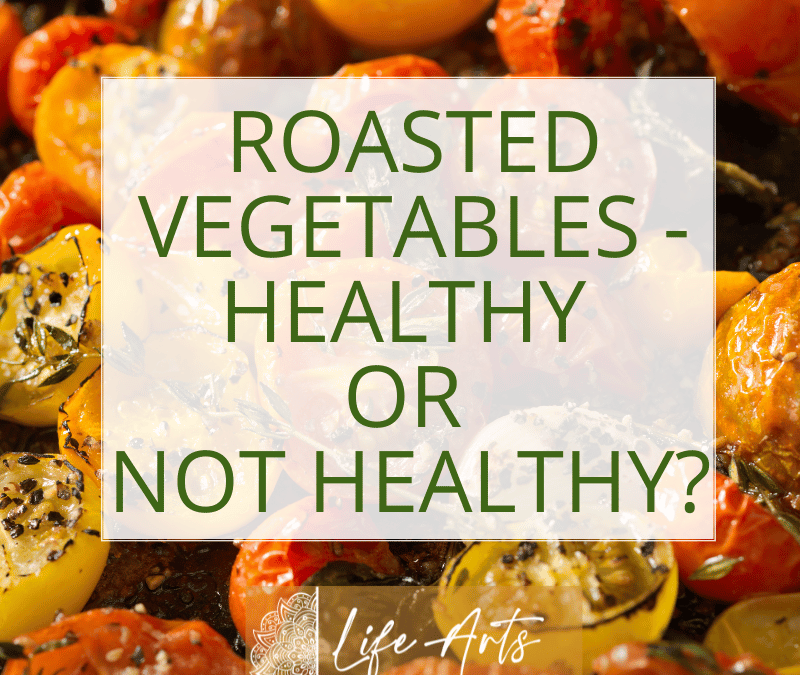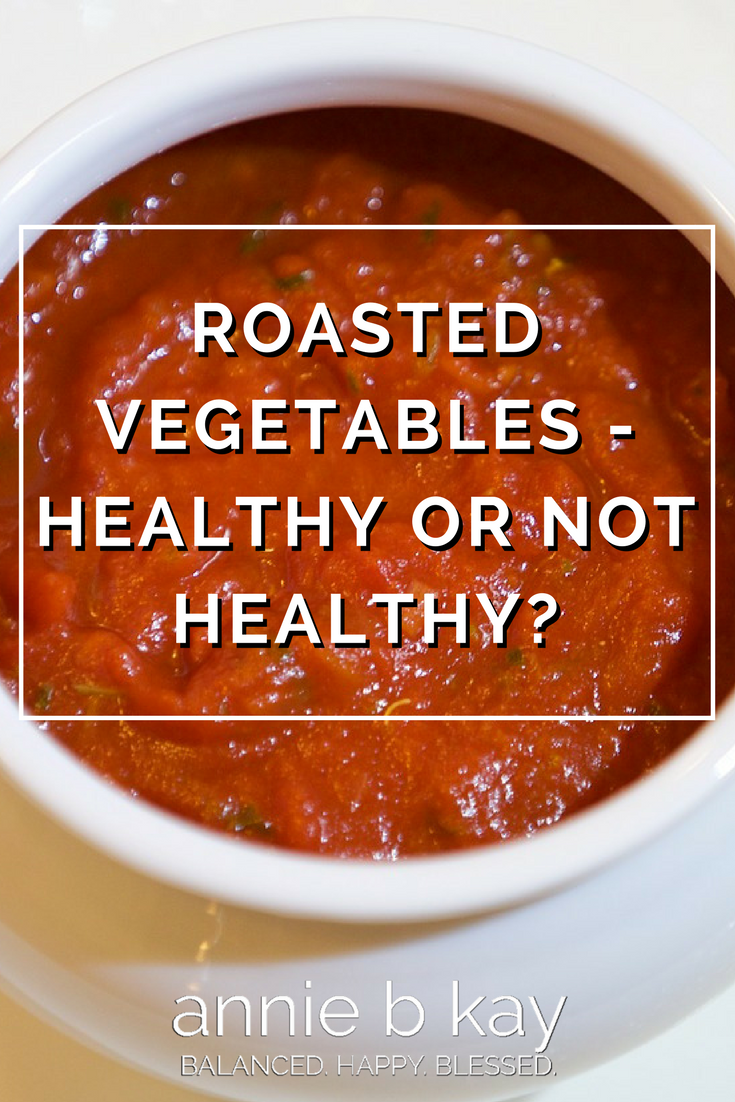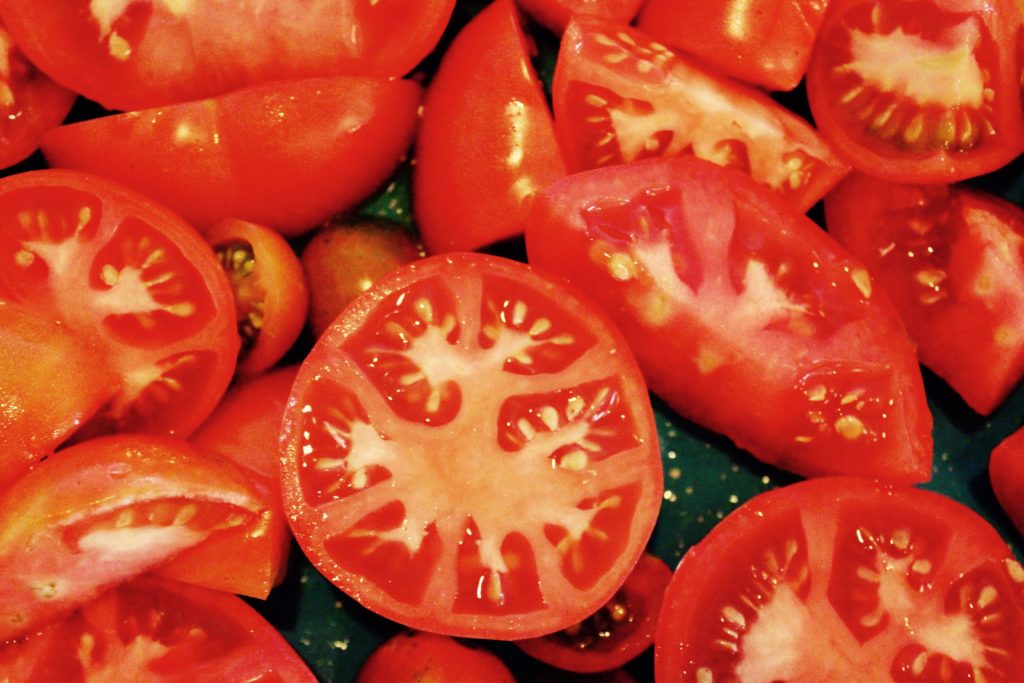
Roasted Vegetables – Healthy or Not Healthy?
Roasted vegetables – baked with a drizzle of olive oil until they have a toasty color and flavor – are a mainstay of my fall and winter kitchen. I give my tomatoes and onions a light roast before pureeing them into soups and sauces and love that sweet roast flavor.
Let’s delve into the intriguing debate surrounding roasted vegetables – a culinary delight – that has captured the attention of health-conscious individuals and foodies alike. With their appealing appearance and intensified flavors, roasted vegetables have become a staple on many dinner tables. However, beneath their enticing facade lies a question that begs: Are these delectable dishes truly as wholesome as they appear, or are there aspects that warrant pause?
In the following exploration, you’ll navigate through the realm of roasted vegetables. I’ll shed light on their potential health benefits, the intricacies of their cooking process, and factors that might influence their nutritional value. Following a few simple tips will insure that your roasted vegetables are as healthful as they are flavorful.
This post contains affiliate links. If you purchase through an affiliate link, I may receive a small commission at no additional cost to you. Thank you. You can read my full disclaimer here.
Benefits of Roasting Vegetables
Roasted vegetables have garnered a well-deserved reputation as a culinary multitasker that not only pleases the palate but also nourishes your body. As we uncover the nutritional benefits that lie within this cooking method, you’ll discover why roasted vegetables deserve a prominent place on your plate.
Concentrated Flavor and Aroma
One of the undeniable advantages of roasting vegetables is the way it intensifies their natural flavors. The high heat of roasting caramelizes the vegetable’s sugars, resulting in a delightful sweetness that enhances their taste. The Maillard reaction, a chemical process that occurs during roasting, contributes to the creation of complex, rich flavors and aromas that can transform even the most humble vegetable into a gourmet delight. So, that seemingly ordinary carrot or cauliflower becomes a culinary star when roasted to perfection.
Nutrient Retention
While generally cooking foods lightly preserves nutrition, sometimes, cooking can aid digestibility and absorption of nutrients. Thoughtful roasting can preserve a substantial portion of a vegetable’s vitamins and minerals. Some nutrients are sensitive to heat, but roasting typically retains a significant amount of essential compounds. For instance, antioxidants like vitamin C and beta-carotene are fairly stable during roasting, ensuring you reap the benefits of these nutrients. A few nutrients – like lycopene in tomatoes – are more available when the tomato is cooked, breaking down the cell walls to release the nutrient. To optimize nutrition with roasting, the key is to avoid overcooking; a delicate balance – think lightly toasted – ensures optimal nutrient retention. When you see black char – you’ve gone too far!
Digestible Fiber
Fiber, the unsung hero of a healthy diet, remains relatively steadfast even in the face of roasting. In fact, the gentle cooking process can soften the fiber slightly, making it easier for your body to digest and absorb. The result? A more comfortable eating experience and a digestive system that appreciates your choice of roasted veggies. Plus, the fiber in roasted vegetables promotes feelings of fullness, aiding your feeling gently satisfied with a moderate portion.
Unique Culinary Opportunities
Roasting vegetables opens a world of culinary creativity. From Brussels sprouts to bell peppers, nearly any vegetable can be transformed into a delectable dish through the art of roasting. Experimenting with various vegetables, herbs, and seasonings allows you to tailor your roasted creations to your taste preferences. The variety of colors, textures, and flavors that emerge from your oven can elevate your meals and help you eat a rainbow of nutrients.
Versatility and Meal Prep
Roasted vegetables are versatile workhorses in the kitchen. They make an excellent side dish, complementing a wide range of proteins and grains. Furthermore, roasted vegetables can be used in salads, omelets, sandwiches, and even pureed into soups. With a batch of roasted veggies on hand, you’re equipped for quick and nutritious meals throughout the week. This versatility not only saves time but also encourages you to eat your vegetables.
Roasted Vegetable Seasoning Ideas
Wondering how to season your vegetables for roasting? I love spice blends – they save time & there are some very tasty ones out there. Our friends at Amazon have a few ideas.
Master the Art of Healthy Roasted Vegetables
When roasting vegetables it’s essential to strike a balance between flavor and nutrition. Here are some tried-and-true tips that will help you elevate your roasted vegetables game while keeping health in mind.
Choose the Right Oil
The choice of oil plays a pivotal role in the healthiness of your roasted vegetables. Opt for heart-healthy oils like light olive oil, which is rich in monounsaturated fats and boasts a moderately high smoke point (smoke point is the temperature at which an oil begins to smoke – or burn – becoming more oxidized and creating compounds your body needs to clear). These oils add a luscious texture and enhance flavors without overpowering the natural taste of the vegetables. Remember, a little goes a long way – use a light hand with oils. A less refined, more flavorful cold-pressed extra virgin olive oil tends to have a lower smoke point, so rather than roasting with it, you might drizzle a bit over your vegetables at the end of roasting.
Other high smoke point oils include grapeseed oil, coconut oil, ghee or clarified butter, and avocado oil. My friends at Mountain Rose Herbal have a nice chart that goes deeper into the smoke point of different oils.
Embrace Seasonings
Herbs and spices are your friends when it comes to adding depth, dimension – and nutrients – to your roasted vegetables. Herbs like rosemary, thyme, and oregano infuse a burst of aroma and taste, while spices like cumin, paprika, and turmeric introduce a delightful complexity. A spice blend or two can be handy! These additions not only enhance the sensory experience but also offer the nutritional benefits of antioxidants, making your dish a nutritional powerhouse.
Mind Your Temperature
Roasting at moderate temperatures (around 375°F to 425°F or 190°C to 220°C) strikes a balance between achieving that desirable caramelization and preventing excessive charring or acrylamide formation. High heat can potentially degrade nutrients and produce harmful compounds, so ensure a gentle and controlled roasting environment.
Consider Parchment Paper or Silicone Mats
You can minimize the need for excessive oil – and make clean-up easier – by roasting your vegetables on parchment paper or silicone baking mats. These non-stick options provide an excellent surface for roasting while reducing the amount of oil required. Your vegetables will still achieve that sought-after crispiness without the added calories.
Here are some examples:
Preheat Your Pan
Preheating your roasting pan or baking sheet before adding the vegetables can help achieve optimal caramelization and prevent sticking. This technique encourages a golden exterior while preserving the natural moisture of the vegetables, resulting in a delightful contrast of textures.
What pan to use? I like a heavy stainless steel baking sheet with a rack. I’m a fan of enameled cast iron – heavy and lovey – but haven’t found my perfect roasting pan yet (I do, however, have an enameled cast iron Dutch oven – so good!). Here’s one well-rated pan for roasting vegetables:
Cut Uniformly (Knife Skills!)
When preparing your vegetables for roasting, aim for a uniform size of slice. This ensures even cooking and prevents some pieces from becoming overcooked while others remain underdone. Consistent sizes also contribute to an aesthetically pleasing presentation.
A nice sharp knife can help. I can vouch for Henckels. You really just need one good chef knife – I like an 8″, and then a pairing knife. Here’s Amazon’s Henckels:
Stir, Flip & Practice Patience
During the roasting process, occasionally stir or flip your vegetables to ensure even cooking and browning. This technique prevents burning and promotes a delightful crispness on all sides.
Roasting is a slow and steady process that rewards patience. Avoid rushing by cranking up the heat, as this may lead to uneven cooking and potentially compromise the nutritional integrity of your vegetables. A little extra time is a small investment for a delectable and nutritious outcome.
Final Roasting Thoughts
In the end, chef, know thyself. If you (like I) are one who knows two stovetop burner settings – high and off – then get to know this idea of an oil’s smoke point. If you put the pan on the stove, turn it to high, pour in the oil, and wait until it smokes – get yourself a bottle of high-temp grapeseed oil.
Do You Have a Roasting Vegetables Story or Dilemma?
I want to know! Leave me a comment.
If this article was helpful or inspiring, lucky you. I’ve got more. You can check out my blog, or sign up for my twice-monthly newsletter to stay in touch.
Looking for a holistic dietitian to help you address looming medical issues? Set up a free 30-minute discovery call to tell me about you and see if we’re a good fit.




